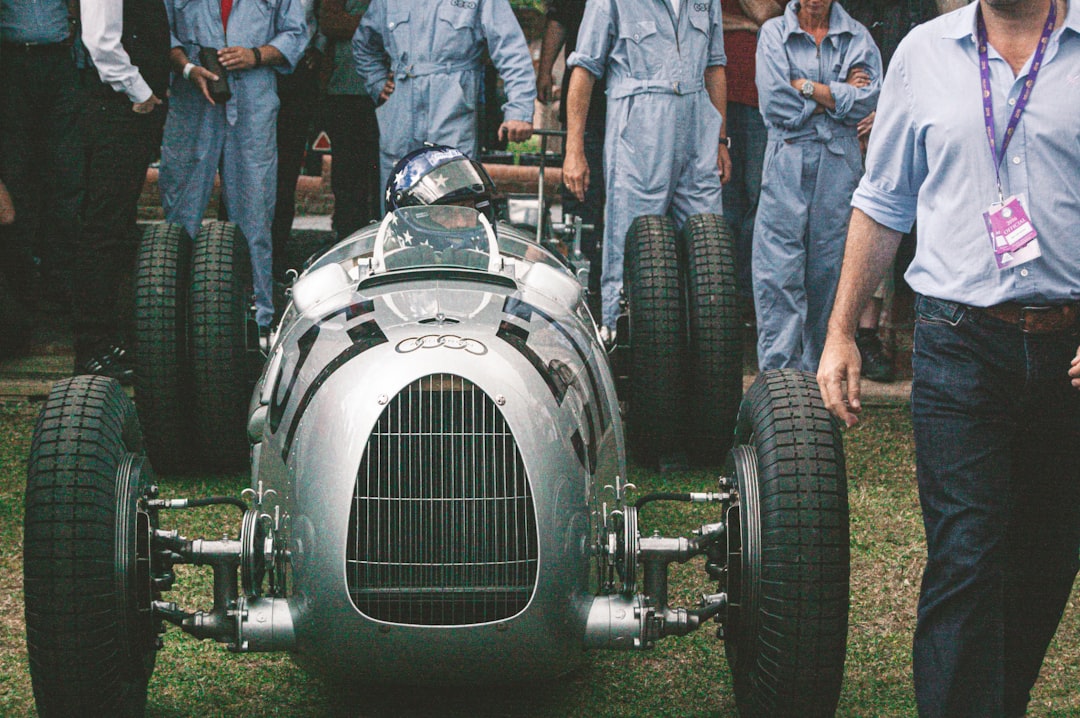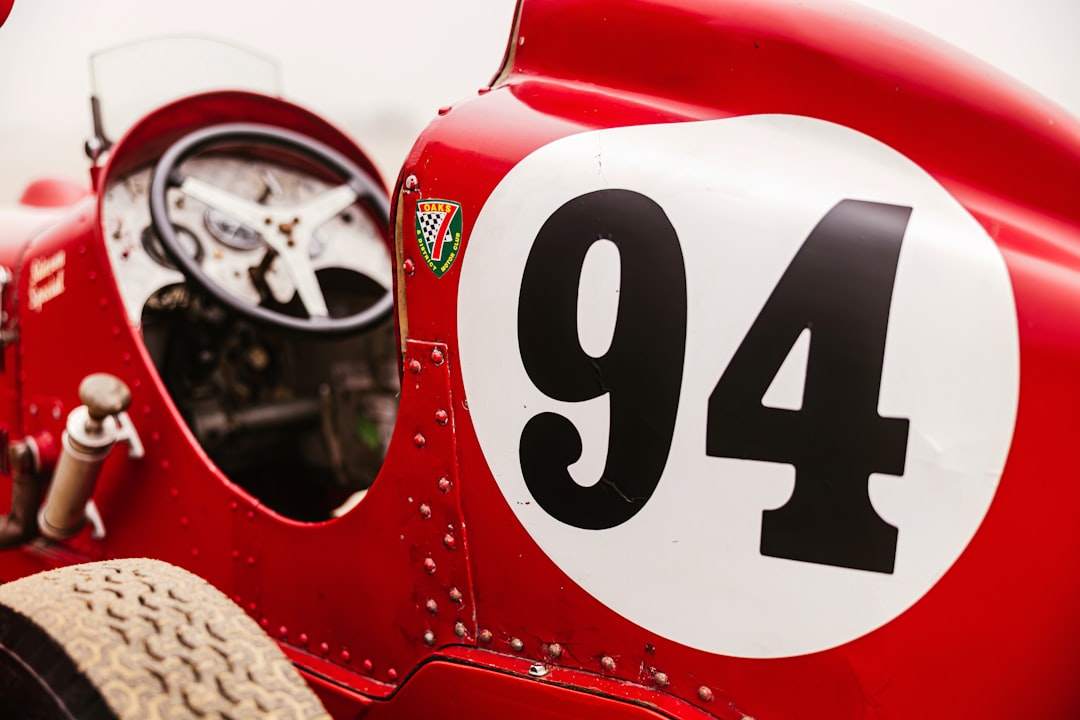

Engage prospects with a scan and streamline customer engagement with FREE QR code marketing tools by Sona – no strings attached!
Create a Free QR CodeFree consultation

No commitment

Engage prospects with a scan and streamline customer engagement with FREE QR code marketing tools by Sona – no strings attached!
Create a Free QR CodeFree consultation

No commitment
Model car racing hobbyists and businesses commonly grapple with turning offline interest into measurable online engagement, a challenge made more difficult by the highly tactile, event-driven nature of the industry. Traditional methods like paper sign-up sheets, static brochures, or untracked event flyers often fail to capture the full spectrum of interest, leaving many promising prospects unrecorded and potential club members or buyers anonymous. This lack of visibility means high-value leads can slip away unnoticed, diminishing efforts to grow clubs, increase event participation, or boost RC product sales.
Moreover, the competitive landscape, crowded club calendars, frequent car enthusiast events, and event-driven marketing compound these difficulties. It becomes all too easy for a racing business or organization to miss timely outreach opportunities, with precious contact details going uncaptured until days or weeks after initial interest has waned. Meanwhile, difficulty attributing specific marketing touchpoints to revenue makes it harder to refine campaign spending and prove ROI.
To bridge these gaps, more model car racing organizations are utilizing QR codes as frictionless connectors between physical moments and interactive digital journeys, as covered in Sona QR’s marketing guide. QR codes are embedded in brochures, event banners, pit passes, and product packaging, offering instant access to sign-up forms, community forums, special offers, and trackable actions. This guide provides practical strategies for deploying QR codes to create valuable touchpoints, automate lead capture, and build measurable high-intent audiences, while showcasing workflow automations and analytics that help scale impact with less manual work.

The conversion roadblock most often faced by model car racing organizations centers on missing high-value prospects because analog workflows like paper sign-up sheets, raffle tickets, and manual contest entries fail to track every interaction. Without an easy way to capture leads as they engage, opportunities for follow-up and nurturing are quickly lost. Attendees glance at a flyer, try a demo on the mini track, or talk with a club lead at a booth, then walk away without leaving a trace.
Modern solutions replace these blind spots with QR-enabled experiences that capture interest in real time. Deploy codes at key journey points such as race-day check-ins via Sona QR ticketing, event kiosks, pit signage, and equipment packaging. The moment someone scans, a digital flow can request contact details, auto-qualify interest with one or two intent questions, and trigger an immediate follow-up sequence. This transforms anonymous enthusiasm into measurable, actionable engagement that drives conversions across membership, events, and product sales.
By automating both lead capture and audience qualification through QR codes, model car clubs and retailers can react in real time, shortening the lag between interest and follow-up. The result is a consistent uptick in conversions because no one slips through the cracks after that first spark of engagement. If you want to streamline the end-to-end workflow, Sona QR supports dynamic codes, segmentation, and integrations that make this entire process easier to execute and scale. Start creating QR codes for free.

One persistent frustration in this niche is the inability to see which anonymous fans, curious buyers, or racing newcomers are engaging at events but not filling out a form or making an immediate purchase. When interest remains invisible, organizations struggle to prove what marketing works, waste budget, or lose momentum after a great conversation at a booth. The gap between a physical spark and a digital action is where many clubs and shops lose the lead.
QR codes create instant, trackable bridges between offline interactions and digital engagement. Every physical asset can become a gateway to your online ecosystem. When a racer sees a schedule change, a parent wants a beginner’s guide, or a buyer needs setup help, one scan can take them straight to the right destination. This reduces friction and increases the likelihood that intent becomes measurable action.
For example, clubs can route event signage scans to live track maps or mobile-optimized membership forms. Hobby shops can add packaging QRs that lead to tutorials, firmware updates, car history, or review prompts. Even pit passes can include a code for instant waiver signing or emergency contact updates. Each scan captures interest that would otherwise disappear after the engines quiet down.

Choosing the right QR format ensures the action you want gets taken without friction. In model car racing, people scan in fast-paced environments such as crowded expo halls or noisy tracks, or in focused moments at home while unboxing a product. Your format should fit the context and the outcome you seek.
Some formats will be used more frequently than others in this vertical. For instance, quick web links and forms are essential for event check-ins and memberships. vCards help club officials and team leads get saved to phone contacts. SMS and email pre-fills are perfect for review requests or customer support. Wi-Fi access codes make it easier for attendees to upload user-generated content. App downloads can help clubs build a deeper digital community.
Whenever you plan to update destinations over time or want analytics for optimization, use dynamic QR codes. If the link will never change and you do not need analytics, static codes can work. Many organizations start with dynamic codes across the board to keep flexibility high and measurement simple. With Sona QR, you can manage multiple code types, switch destinations as offers change, and track performance from a single dashboard.
Many clubs and shops put QR codes in obvious places but miss the touchpoints where intent is highest. Growth comes from placing codes where people have a reason to take action right now. Consider both the high-traffic zones and the high-intent micro-moments where a scan naturally fits the user’s need.
Think through the entire lifecycle. Enthusiasts discover your brand at expos, browse in-store displays, attend weekend meets, and unbox at home. Each moment can produce a meaningful scan when paired with a relevant destination. By targeting these interactions, you can surface first-party signals that support cross-sell, upsell, and timely follow-up across channels.
When you strategically place QR codes where hobbyists are already looking and deciding, you increase the likelihood of meaningful engagement. The additional data you capture informs smarter campaigns, better scheduling, and more relevant offers over time.

Without a fast digital avenue in the moment, valuable leads often leave events or shops without leaving their details. This causes avoidable drop-off at the top of your funnel and complicates basic planning. With QR codes, you can meet people where they are with clear next steps and trackable outcomes.
Model car racing teams, clubs, and retailers can unlock a range of practical use cases that tie offline energy to online action. Each use case should align to a business goal such as increasing membership, capturing event data, or generating social proof for your store.
By connecting physical engagement with digital capture, you create a reliable pipeline of first-party data. This supports timely follow-up, personalized offers, and a richer community experience that keeps people involved beyond the initial interaction.
Every scan is a signal. It tells you who was interested, what they were interested in, and where they were when interest peaked. By deploying unique QR codes across your touchpoints and mapping them to journey stages, you can segment audiences automatically and retarget with precision across email, SMS, and paid media, guided by Sona’s retargeting playbook.
In the model car racing world, not all scanners are the same. A first-time spectator at a local event has different needs than a seasoned racer upgrading parts. Parents helping kids get started need different content than hobbyists who compare motors and setups. When your segments reflect these realities, your campaigns resonate and your conversions improve.
With a platform like Sona QR, each code becomes a smart entry point that adds context to your audience. You can build segments such as racers vs collectors, parents of junior racers vs adult competitors, local club members vs regional event travelers, and first-time buyers vs repeat buyers. These distinctions enable you to reach the right people with the right message at the right time.
When QR codes sit in isolation on a random poster or one-off flyer, you miss their real power. The magic happens when QR codes connect your offline world with your digital campaigns across channels in a coordinated way. This unified approach lets you measure impact everywhere and steer budget to the assets that work best.
For model car racing organizations, the most effective deployments meet people in the environments they already love: bustling expo halls, lively weekend meets, retail showrooms with demo tracks, and the unboxing moment at home. Match the code to the context and your engagement will rise.
QR codes work best when the destination matches intent and the data flows into your broader marketing stack. With Sona QR, you can centralize code management, monitor performance in real time, and sync scan activity to your CRM and ad platforms so the offline-to-online loop is always closed.
Consistency is the difference between a one-off experiment and a repeatable growth engine. The following checklist streamlines planning, keeps your creative aligned with goals, and ensures you capture the data you need to improve each time.
Define the single outcome you want to drive. Are you focused on increasing race-day check-ins, growing club membership, collecting product reviews, or promoting post-event sales on parts and upgrades? Pick one use case per code to reduce confusion and maximize conversion.
Align your call to action with the exact moment and audience. For example, at the pit entrance use “Scan to check in” with an instant waiver flow. On a kit box use “Scan to set up your car in 5 minutes” that goes to a quick-start video and registration form.
Choose static codes for destinations that never change such as a PDF of track rules. Choose dynamic codes when you need analytics, retargeting, or the ability to update the link later. Dynamic is ideal for event schedules, limited-time offers, and campaigns you want to optimize over time.
Format matters as well. Web links are the default for most goals. Consider vCards on staff badges, SMS pre-fills for review requests, and Wi-Fi codes at large events. The simpler you make it for the scanner, the more completions you will see.
Codes should be visually integrated with your brand and accompanied by a clear promise. Add a short headline that highlights the benefit and a small arrow or frame that makes the scan target obvious. Keep sufficient contrast, avoid glossy surfaces, and size the code for the likely scan distance.
Before going live, test across devices and environments. Scan from different angles, in low light near the pits, and under bright expo hall lights. Check that your landing pages load quickly on cellular networks and that forms are optimized for mobile input.
Roll out QR codes to the places where they will be seen and used most. At events, prioritize entry points, pit boards, and big screens. In-store, focus on demo tracks, checkout counters, and window displays. In the field, add codes to volunteer shirts, trophies, and award certificates to catch attention when excitement peaks.
Match destinations to each placement. A code at the gate should never go to a generic homepage. A code on a racing kit should not send someone to a club calendar. Make every scan feel like it was designed for that exact moment.
Use analytics to understand which assets, messages, and locations produce the highest scan-to-conversion rates. Compare results across events, test different CTAs, and switch destinations on dynamic codes if you see drop-off. Build a feedback loop where each campaign informs the next.
Integrate scan activity into your CRM to trigger follow-ups automatically. Send a welcome email after a membership sign-up, a setup checklist after product registration, or a VIP offer to those who scanned at multiple events. Over time, these small improvements compound into major gains.
With a disciplined approach to planning, design, deployment, and optimization, your QR efforts will mature from occasional experiments into a reliable growth system. Platforms like Sona QR make it straightforward to manage dynamic codes, analyze performance, and orchestrate follow-ups at scale.

Proving the impact of offline marketing has always been difficult; see Sona’s offline attribution for frameworks. Many model car organizations invest in printed assets and event presence, yet they cannot tie those investments to outcomes such as membership growth, parts sales, or returning attendees. QR-enabled analytics close that loop by logging each scan, attributing it to specific assets, and connecting it to downstream behavior.
Modern platforms can go beyond simple scan counts to reveal which placements drive meaningful actions. By syncing data into your CRM and marketing tools, you can see who came from where, what they did next, and whether the engagement produced revenue or long-term community value. This insight empowers smarter decisions about creative, offers, and budget.
Sona QR captures real-world engagement with codes you control and can edit at any time. Sona, an AI-powered marketing platform that turns first-party data into revenue, extends that value with identity resolution, multi-touch attribution, and Buyer Journeys views that tie QR activity to pipeline and revenue. Together, they help you make QR part of your performance marketing engine, not just a convenience for your customers.
Once your first QR campaigns are in market, you can expand their impact by sharpening segmentation, improving creative, and building automation that turns a single scan into a complete journey. Focus on the places where your audience already interacts and the actions they are most likely to take.
For model car racing clubs and retailers, success often comes from adding QR codes to overlooked surfaces and training staff to promote the value of scanning. A small reminder from a volunteer or cashier can dramatically improve scan rates, especially when paired with a clear benefit.
Creative deployment ideas include adding QR codes to lap-time slips for instant social sharing and leaderboard access, placing a code on trophy plaques that links to a winners’ gallery, or printing a small QR on pit crew shirts that opens a vCard for the team lead. These touches create memorable interactions while capturing measurable data.
The most compelling evidence comes from the field. Clubs and retailers across the model car racing community have turned QR experiments into reliable growth levers by targeting key moments and following through with automation.
Consider a regional club that noticed event enthusiasm was not translating into memberships. They deployed dynamic QR codes at entrances and vendor booths, offering a “Scan to Join in 60 Seconds” path with a mobile-optimized form. Automated emails and SMS welcomed new members and offered a first-race discount. Over the season, the club saw a 30 percent increase in enrollments, and they reduced manual data wrangling to nearly zero.
These examples highlight practical ways QR ties physical presence to measurable outcomes. Each idea starts with a clear goal, a relevant placement, and a short path from scan to success. The follow-through is where the compounding value appears, as the right messages reach the right people at the right time. For more inspiration, watch this overview of QR in automotive.
Even solid QR campaigns can underperform if the destination experience feels generic or the code is hard to scan. Many model car organizations also underestimate the importance of human enablement. When staff and volunteers actively promote the benefit of scanning, participation and conversions rise quickly.
To build consistently strong results, combine field-tested guidelines with ongoing iteration. Treat each code as a mini funnel that begins with a compelling promise and ends with a clear, trackable outcome.
Consistent education, real-world testing, and attention to environment are the difference between a nice-to-have code and a high-performing conversion channel. Keep improving each deployment and your results will compound.
As model car racing organizations navigate the intersection of a tactile hobby and digital transformation, QR codes offer an unobtrusive yet powerful on-ramp for engaging fans, capturing intent, and measuring progress. Whether your goal is to grow memberships, streamline event check-ins, increase product reviews, or build community, QR codes help you convert physical interest into digital action you can track and optimize. The strategies in this guide show how to turn every surface into a smart touchpoint and every scan into a step forward.
With a platform like Sona QR, you can generate dynamic codes, manage destinations, and centralize analytics in one place, while Sona.com connects scans to pipeline and revenue with identity resolution and multi-touch attribution. Start by deploying a few high-intent use cases at your next meet or in your store, then expand based on the data. Capture demand at the source, retarget intelligently, and build lasting value wherever your next race, event, or campaign takes you. Start creating QR codes for free.
QR codes have transformed the model car racing industry from a niche passion into a dynamic platform for growth and engagement. Whether it’s attracting new hobbyists, enhancing event experiences, or streamlining sales of parts and collectibles, QR codes turn static materials—like race flyers, packaging, and trackside displays—into interactive touchpoints that capture real-time data and drive conversions. Imagine instantly knowing which promotions bring in the most racers or which product links lead to repeat purchases.
With Sona QR, you can effortlessly create dynamic, trackable QR codes that update instantly without costly reprints, linking every scan directly to your business goals. From promoting upcoming races to showcasing exclusive offers, Sona QR helps you connect scans to revenue and build a loyal community. Start for free with Sona QR today and shift your model car racing business into high gear—turning every scan into a winning move.
Model car racing clubs and businesses can engage their audience online by using QR codes embedded in brochures, event signage, pit passes, and product packaging to capture leads, automate follow-up, and track engagement in real time.
High-quality RC car brands and related products are typically available through hobby shops and retailers that support the model car racing community, who also often provide QR codes linking to tutorials, setup guides, and warranty activation.
Starting a model car racing business involves engaging the community with clear goals such as increasing memberships and sales, deploying QR codes to capture leads and automate follow-ups, strategically placing codes at high-intent touchpoints, and using analytics to optimize marketing efforts.
Top model car racing events include regional club meets, expos, and weekend races where QR codes are often used for check-ins, schedules, and interactive features, helping attendees engage with the community and access real-time information.
Reliable information on building and maintaining model race cars can be accessed through QR codes on product packaging or club materials that link to quick-start videos, setup guides, firmware updates, and community forums.
QR codes are important because they create instant, trackable connections between offline interactions and digital engagement, enabling clubs and businesses to capture leads, automate follow-ups, update content dynamically, and measure marketing impact effectively.
By placing QR codes at venue entrances, pit gates, and local meetups directing scanners to mobile-optimized forms for instant waivers and sign-ups, you can speed up check-ins, capture data accurately, and increase membership conversions.
Web links are most versatile for sign-ups and schedules, vCards help save contacts, SMS or email pre-fills are effective for quick outreach, Wi-Fi access codes facilitate network connections at events, and app download codes encourage community app adoption.
Success is tracked by logging each scan's details such as time, location, and source asset, syncing data with CRM systems, comparing scan-to-conversion rates across placements, and using real-time analytics to optimize campaigns and attribute revenue.
Common mistakes include placing codes on reflective or moving surfaces, using generic destinations that do not match context, failing to educate staff and volunteers to promote scanning, and neglecting timely follow-up communications after scans.
Use Sona QR's trackable codes to improve customer acquisition and engagement today.
Create Your FREE Trackable QR Code in SecondsJoin results-focused teams combining Sona Platform automation with advanced Google Ads strategies to scale lead generation

Connect your existing CRM

Free Account Enrichment

No setup fees
No commitment required

Free consultation

Get a custom Google Ads roadmap for your business






Launch campaigns that generate qualified leads in 30 days or less.
